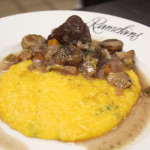Pork Stew with Chestnuts served with Pumpkin Polenta
This recipe was originally prepared with wild boar, a rare commodity at most markets. I always use pork shoulder for this dish, however, and the results are sensational. If you want to try the more exotic version, ask your butcher to order some boar for you. True wild boar, rather than farm raised, would need to be marinated in the wine and vegetables for a few days to tame the gamey taste before it could be cooked. But if you are using pork or even farm-raised boar, you can marinate it overnight to infuse it with flavor if you like, or you can skip the marinating. The chestnuts make a superb addition. Peeling them is tedious work, of course, but the effort is worth it in this case, as the nuts add immeasurable sweetness and richness to the stew. If fresh chestnuts are not in the market, use dried chestnuts or vacuum-packed cooked chestnuts. Serve the stew with polenta.
The Pumpkin Polenta is a blend of a classic Northern Italian ravioli filling and baked polenta. The sweetness of the squash and the richness of the cornmeal provide a fine accompaniment for meat or poultry. The polenta can be served soft. Any left over polenta can be turned out onto a baking dish, refrigerated, then cut into cakes and baked or sauteed.”
Ingredients
- 1 1/2 pounds fresh chestnuts, or 1/2 pound vacuum-packed cooked chestnuts
- Salt
- 5 to 6 tablespoons olive oil
- 1 yellow onion, finely chopped
- 2 carrots, peeled and finely chopped
- 1 celery heart, finely chopped
- 6 to 8 fresh sage leaves, finely chopped
- 2 pounds boneless pork shoulder, cut into 2-inch pieces
- Freshly ground black pepper
- 6 juniper berries, smashed; 4 or 5 whole cloves; and 1 cinnamon stick, 3 inches long, tied in a cheesecloth sachet
- 3 cups Valpolicella or other dry red wine
- 2 1/2 pounds butternut squash or 2 pounds yams or sweet potatoes
- 1/4 cup milk
- 4 tablespoons softened unsalted butter plus more for gratin dishes
- 1 teaspoon freshly grated nutmeg
- 2 cups coarse cornmeal for polenta
- 7 cups cold water
- salt, pepper
- 2-3 tablespoons chopped fresh sage
- 1 cup grated parmesan cheese
- optional; chopped toasted hazelnuts
Instructions
- If using fresh chestnuts, cut an X on the flat side of each chestnut. Place the chestnuts in a saucepan, add water to cover, bring to a boil, salt lightly, and boil for 5 to 10 minutes. Remove from the heat. Lift the chestnuts from the water one at a time and peel, starting at the X and removing both the hard outer shell and the bitter inner skin (they are easiest to peel while still hot). Set the peeled chestnuts aside. If using vacuum-packed chestnuts, set aside.
- In a large sauté pan, heat 2 tablespoons of the olive oil over medium heat. Add the onion, carrots, celery, and sage and sauté until pale gold, about 12 minutes. Using a slotted spoon, transfer the vegetables to a Dutch oven.
- Return the sauté pan to high heat and add 2 to 3 tablespoons of the olive oil. Working in batches, brown the pork on all sides, adding oil as needed and seasoning with salt and pepper as you turn the meat. Each batch should take 8 to 10 minutes. As each batch is ready, use a slotted spoon to transfer it to the Dutch oven.
- When all of the pork has been browned, add the spice sachet and wine to the Dutch oven. Place over medium heat and bring to a gentle boil. Reduce the heat to low, cover, and simmer until the meat is tender, about 1 1/2 hours, adding the chestnuts during the last 20 minutes.
- Remove and discard the spice sachet. If there is too much liquid in the pot, use a slotted spoon to transfer the pork and chestnuts to a bowl. Return the pan to high heat and boil the pan juices until they are reduced to a good consistency. Return the pork and chestnuts to the pan, reheat gently, then serve.
- Variation: Add 1/2 cup grappa- or Cognac-plumped prunes with the chestnuts.
- Preheat oven to 400 degrees. Bake the yams and or squash until soft, about 1 hour. If using yams or sweet potatoes, peel and mash. Or if using squash, cut in half, scoop out the seeds and mash or put through a ricer. Beat in milk and butter. Season with nutmeg, and a pinch of cinnamon if desired, and salt and pepper. Set aside.
- Combine polenta and cold water in a large saucepan and stirring quite often, bring up to a boil. Reduce heat and simmer over low heat, stirring often, until thickened, about 30 minutes, or until cornmeal is no longer grainy on your tongue. Add more water if needed until polenta is cooked. Whisk in pureed squash, parmesan and chopped sage, and mix well to combine. Season again with salt, pepper and nutmeg. Serve hot.
- If making polenta cakes, pour into a well buttered or parchment lined baking pan (16x12x1) and refrigerate. When firmed up, cover well with plastic wrap. When polenta is firm and cold, cut into desired shapes such as triangles, rectangles, squares or strips, with a knife or biscuit cutter (if you want rounds.) Cover with plastic wrap and refrigerate until ready to bake or saute.
Notes
Recipe and notes courtesy of Joyce Goldstein, from Italian Slow and Savory.
Recipe Source: LickMySpoon.com.
Hello! All images and content are copyright protected. Please do not use our images without prior permission. If you want to republish this recipe, please re-write the recipe in your own words, or simply link back to this post for the recipe. Thank you!



